Log in or create new account to save this product to your wishlist.
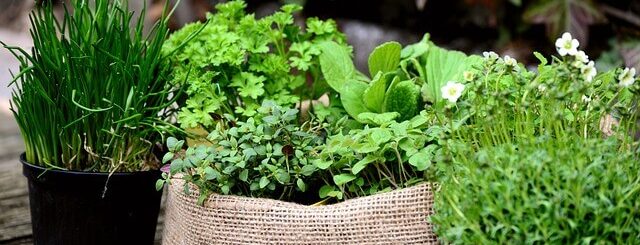
How to Create & Grow Your Own Herb Garden
Learn everything about growing & caring for your own herb garden with our top tips. Before you know it, you'll be cooking with herbs from your own garden.
🌱 All important maintenance moments for your lawn during the year. Leave your email and we will send you the lawn calendar for free.
Enter your email
Receive the lawn calendar in the mail
Enjoy a green lawn all year round!

- Order by 2PM = shipped today
- 250.000+ satisfied customers!
- 60 day satisfaction guarantee
Do you love the zing that fresh herbs bring to your food but always forget to buy them from the supermarket? Or maybe you’re looking to save money on your food bill? Well, luckily, a herb garden is a cheap way to gather all the herbs you’ll need while providing plenty of satisfaction.
- Preparing for a herb garden
- When to sow herbs
- Types of herb gardens
- Indoor vs outdoor herb gardens
- Which herbs do I choose?
- Creating a herb garden: a step-by-step plan
- FAQs
Creating a herb garden is fun and relaxing. So, whether you have a few pots on your windowsill, a window box, a dedicated planter or a greenhouse, it’s possible to grow and harvest fresh herbs with minimal effort.
This article explores how to create and grow your own herb garden, providing endless fresh herbs to pep up your dinner plate.
Ready? Let’s get started!
Preparing for a herb garden
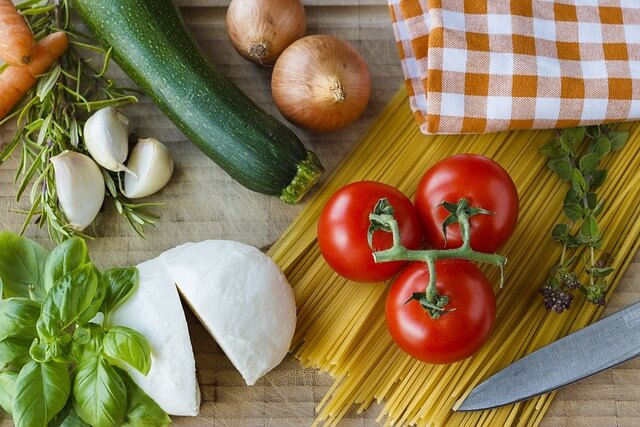
Choose a bright, sunny spot for your herb garden because most herbs need around six hours of sunlight daily for optimal health, vitality, and flavour.
However, some herbs, such as curly parsley, wintergreen, chervil, sweet woodruff, and chives, do well in partial shade. But always ensure the soil remains moist; otherwise, your herbs will grow poorly.
What type of herbs suit your available space?
The location dictates which herbs will thrive. So, for an outdoor herb garden, consider perennial herbs, such as thyme, oregano, bay, lemongrass, lovage, and parsley. These herbs typically return year after year and may require splitting, as they can grow large.
If you have a patio or windowsill space, consider growing your herbs in pots or building a vertical herb garden.
Growing the herbs you use
Of course, the most appropriate herbs to grow are the ones you most regularly use in your cooking.
Maybe you love mint tea? Or perhaps you enjoy homemade pesto? Then, sow mint and basil. But consider going off-piste a little: for example, nasturtiums or horseradish leaves are delicious as a pesto base.
Consider the soil for your herb garden
Mediterranean herbs thrive in sandy soil, which drains well but typically lacks nutrition. This means you may need to treat heavy clay soil, which can become easily waterlogged, improving the soil with well-rotted compost or leaf mould.
If you’re unsure, check out our article about how to analyse your garden soil.
When to sow herbs
If you’re starting your herbs off indoors with the intention of transplanting them in summer, we recommend sowing the seeds in spring.
Always read the packet because herbs sown and germinated too early can become woody or leggy before they’re ready for consumption, leading to a bitter flavour and unpleasant texture.
Growing herbs outdoors
You can plant many herbs, such as parsley, coriander, rosemary, dill, and mint, directly in the ground outside during the summer.
However, for best results, it’s worth starting them off in the greenhouse in pots and then transplanting them once they’re large enough to stand on their own.
Growing herbs indoors
If you have a sunny enough windowsill, you can pretty much sow herb seeds all year round.
This is because your home’s central heating will keep the soil warm enough to germinate, and even bright winter sun will provide enough for the plants to thrive indoors.
Types of herb gardens
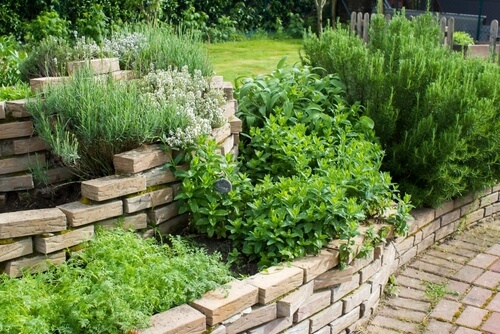
Herb gardens will thrive in sunny spots but can take up a fair amount of floor space. However, several approaches monopolise more on height than breadth:
Traditional veg-patch style herb gardens
If you have plenty of space, build a veg-patch-style herb garden, creating a raised bed and filling it with well-draining light compost. This style is ideal for extensive gardens and can be combined with other vegetable or fruit crops.
Bear in mind that herbs are often more delicate than typical veg-patch plants like potatoes, courgettes, and cucumbers. So, protect your herb garden from strong winds — perhaps planting them next to larger, more robust plants.
A potted herb garden
Patios are great locations for herb gardens because they’re typically in the sunniest spot. And herbs grow excellently in pots because the soil is easier to control.
However, pots dry out more quickly than garden soil, so keep them watered, never allowing them to dry out.
One of the main advantages of growing herbs in pots is that you can move your pots:
- if they’re drying out too quickly, move them into a shadier spot
- looking a little sorry for themselves, move them into full sun
- growing too large, divide them and plant them in individual pots
Spiral herb garden
This is a creative and space-saving way of growing herbs in a compact area. The spiral shape ensures that each plant receives enough sunlight — better than traditional stacking gardens, as draping plants are less likely to shroud lower plants in darkness in this configuration.
You can build a spiral frame, attaching planters to a central beam or buy a ready-made herb spiral.
Vertical herb garden
This configuration is excellent for areas with limited floor space but plenty of wall space. Attach pots or planters to a sunny wall, ensuring there’s enough room between each plant to spread or drape.
Vertical gardens are perfect for people with reduced mobility because you can attach each pot at a reachable height.
Windowsill herb garden
Perhaps the most common choice for many herb lovers, a kitchen herb garden provides immediate access to the freshest herbs you’re ever likely to get.
However, ensure your plants get plenty of sunlight. Choose another room if your kitchen is north-facing.
Indoor vs outdoor herb gardens
There are benefits for both indoor and outdoor growing.
Outdoor herbs
The main benefit of outdoor growing is that your plants have direct access to sunlight (no dirty windows to filter the rays!), and you can rely on summer showers to prevent your plants from drying out.
However, you’re more likely to experience problems with slugs, snails, beetles, and caterpillars, which love to chomp on your tasty herb leaves.
Indoor herbs
The principal benefit of indoor growing is that it’s easier to protect your plants from pests. However, central heating can create dryness in the air, and this can lead to drying out the compost in your pots.
So, you’ll need to water your pots more regularly if you’re growing them indoors.
The other main issue is a lack of sunlight unless you have a south-facing kitchen window. If your window faces east or west, you’ll only receive sunlight in the morning or evening — if you’re facing north, it’s unlikely you’ll get much direct sunlight.
So, choose herbs that grow well in partial shade for east, west, or north-facing windows.
Which herbs do I choose?
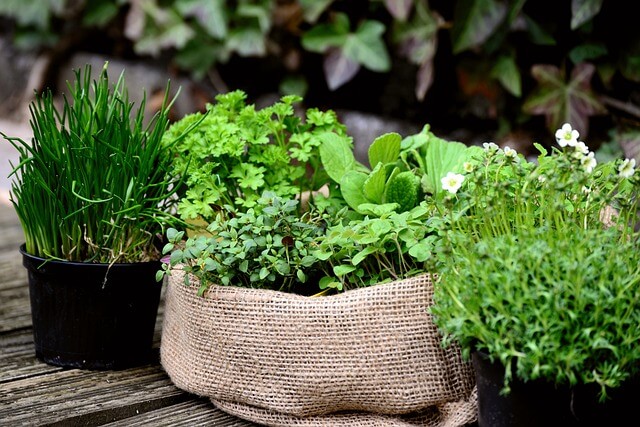
Ideally, choose herbs that suit your home and garden’s microclimate. Consider the amount of direct sunlight, the soil type (improve it or grow in pots if you have heavy clay), and the available space.
Herbs in the shade
These are herbs that tolerate partial or even full shade:
- Miner’s lettuce
- Golden hop
- Chives
- Coriander
- Parsley
- Golden oregano
- Mint
- Sweet cicely
- Angelica
Herbs in poor soil
It’s not always easy to improve the soil — but you can still grow a range of delightful Mediterranean herbs:
- Marjoram
- Oregano
- Rosemary
- Sage
- Thyme
These grow best in full sun and with free-draining soil that lacks nutrients.
Herbs in full sun
You’ll find some crossover here, as many herbs are pretty versatile.
The best herbs for full sun are:
- Basil
- Chamomile
- Chives
- Dill
- Hyssop
- Mint
- Sage
- Organo
- Thyme
Herbs for partial shade
These are the best herb plants for partial shade:
- Angelica
- Chervil
- Parsley
- Sorrel
- Sweet woodruff
- Wild garlic
- Winter purslane
Herbs for dryer soil
Water drains quickly from sandy soil, which can be a problem for many plants. However, some herbs thrive in dry, poorly nourished soils:
- Borage
- Red valerian
- French tarragon
- Lavender
- Rosemary
- Sage
- Thyme
Herbs for damp soil
Clay soils can be particularly wet, making some plant roots rot.
However, some herbs thrive in damper conditions:
- Angelica
- Chervil
- Comfrey
- Horseradish
- Meadowsweet
- Parsley
Creating a herb garden: a step-by-step plan
Here’s a step-by-step plan to herb garden perfection:
Step 1: Determine position
Ideally, choose a sunny spot that’s also protected from winds. If you don’t have a bright spot, never fear — use the lists above to determine which herbs will thrive in your chosen spot.
Step 2: Prepare the ground
Firstly, remove weeds and grass from your chosen position. Dig 30cm into the soil and remove stones, old roots, and other debris.
Then, improve the soil by adding compost or organic manure to increase soil fertility and drainage.
Step 3: Select and plant your herbs
Again, use the list above to determine which plants best suit your herb garden.
Make a planting hole if you’re transferring established plants, or prepare a seed drill if growing directly from seed into the soil.
Leave plenty of room between each plant, giving them space to spread and grow without encroaching on other plants’ sunlight or root space.
Step 4: Keep the compost moist
Herb seeds are often quite delicate, so take care when watering because you can easily wash them away.
Use a watering can rather than a hose to prevent disturbing your seeds or damaging tender foliage.
Never allow the soil to dry out unless you’ve chosen a drought-resistant herb. On the other hand, never allow the soil to become wet and heavy, which is typically more likely with heavy clay soils.
FAQs
Choose a sunny spot on a patio, in your flowerbeds, or even on your kitchen windowsill. Many herbs need full sun, so this is a priority. Select herbs you use most regularly in your cooking, and ensure you have the right conditions for each plant. Most herbs need plenty of water, so never allow the soil to dry.
Sage and oregano are suitable partner plantings. Also, rosemary and thyme grow well in close proximity. Always consider the potential size of the fully developed plant and ensure it has enough space to grow.
Seeds need warm soil to germinate, so wait until early spring before planting seeds, especially if you’re sowing directly into the soil. However, you can grow herbs from seed almost any time of year if you’re growing them indoors.
Any questions?
I hope you’ve got all the information you might need to grow your own herb garden successfully. But if you have any questions, drop us an email.
Alternatively, check out our comprehensive Help & Advice section for your garden and lawn care needs.
Thanks for reading.
-
How to Grow Eucalyptus in British GardensWith a little love and care, eucalyptus trees can thrive in English gardens. Since they don’t germinate well without proper help, there are not considered invasive. So, there is no reason not to plant them if you enjoy their looks.Read more
-
Transform Your Garden with All-Year-Round Flowering PlantsDid you know you can enjoy blooming flowers even in January? With the right selection of all year round plants, there’s no need to wait until spring to add some colour to your garden.Read more
-
How to Create a Butterfly Garden: A Simple Guide for British GardensThe UK's butterfly population includes 59 different species. These beautiful winged creatures face a steady decline because of habitat loss, pollution and changing weather patterns. Your garden can become a vital link between nature reserves and natural habitats. Let’s explore how.Read more
-
Volcanic Rock Dust for Your Garden—Application and TipsDid you know that volcanic rock dust is a brilliant organic soil improver? This article explains exactly what it's good for and how to use it properly.Read more
-
How to Use Landscape Fabric ProperlyIf weeds or erosion in your garden are troubling you, landscape fabric might be the solution. We’ll explain how and when to use it properly, just keep on reading.Read more
-
Hostas: A Complete Care GuideIf you have a north-facing garden or some shady corners on your property, hostas are the plants for you. These green delights thrive particularly well in partial to full shade and require consistently moist soil to perform at their best.Read more
-
How to Grow Grapes in Your Garden: A Simple Step-by-Step GuideGrapevines produce some tasty fruits, but often they are simply grown for their gorgeous leaves. Whatever your motivation may be, we have a guide on how to grow grapes for you.Read more
-
Worm Composting Made Simple: From Kitchen Scraps to Garden GoldDid you know that a single pound of composting worms can devour half their body weight in waste every day? That's roughly twelve pounds of kitchen scraps transformed into garden gold each month! We will look at how to make this happen.Read more
Leave a comment
Your answer will be displayed on the site and the interested party will be notified by email.
Leave a comment
Have a question or want to share your experience? Leave us a comment.

- Order by 2PM = shipped today
- 250.000+ satisfied customers!
- 60 day satisfaction guarantee

- Order by 2PM = shipped today
- 250.000+ satisfied customers!
- 60 day satisfaction guarantee

- Order by 2PM = shipped today
- 250.000+ satisfied customers!
- 60 day satisfaction guarantee

🌱 All important maintenance moments for your lawn during the year. Leave your email and we will send you the lawn calendar for free.
Enter your email
Receive the lawn calendar in the mail
Enjoy a green lawn all year round!












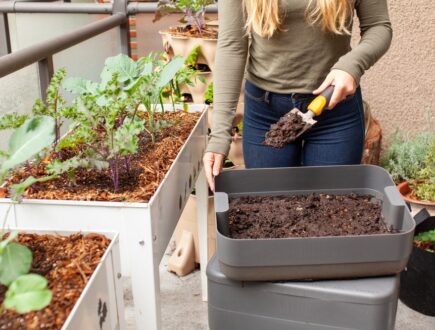



 Summer Deal! Get 15% off the
Summer Deal! Get 15% off the 




Comments (0)
There are no comments yet. Well then, what are you waiting for to
Be the first to write your comment!inaugurate this pretty page?
Do you have some comments?